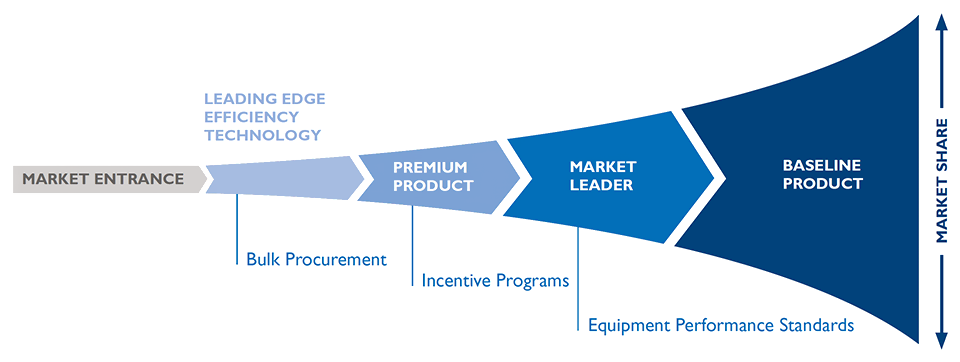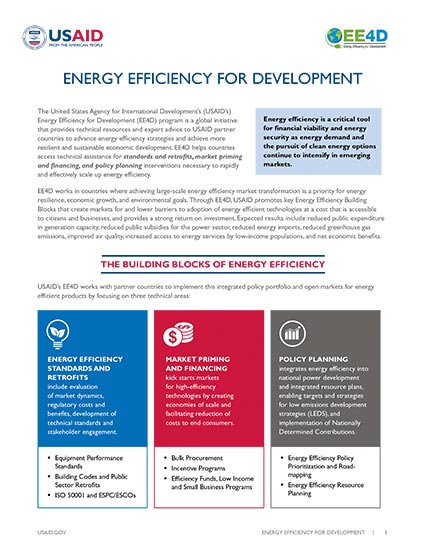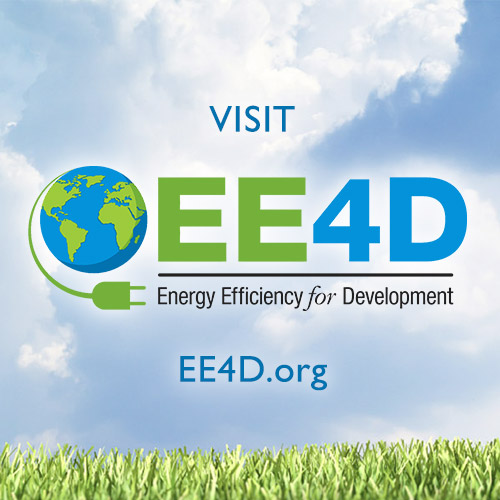This global initiative provides technical resources and expert advice to USAID partner countries in advancing energy efficiency strategies and achieving more resilient and sustainable economic development.
Energy efficiency is a critical tool for financial viability and energy security as energy demand and the pursuit of clean energy options continue to intensify in emerging markets.
USAID’s Energy Efficiency for Development (EE4D) program provides technical assistance to USAID partner countries to scale up clean energy and energy efficiency rapidly and effectively. USAID partners with the Lawrence Berkeley National Laboratory to provide technical assistance to energy system planners, regulators, and utility managers in partner countries to overcome challenges associated with implementing energy efficiency programs. Berkeley Lab works with local stakeholders to identify areas of greatest opportunity, gaps, and barriers in order to better integrate energy efficiency as a resource for sustainable development.
USAID provides services through the EE4D program in countries where achieving large-scale energy efficiency market transformation is a priority for energy resilience, economic growth, and environmental goals. Through EE4D, USAID promotes key Energy Efficiency Building Blocks that create markets for and lower barriers to adoption of energy efficient technologies at a cost that is accessible to citizens and businesses, and provides a strong return on investment. Expected results include reduced public expenditure in generation capacity, reduced public subsidies for the power sector, reduced energy imports, reduced greenhouse gas emissions, improved air quality, increased access to energy services by low-income populations, and net economic benefits.
The Building Blocks of Energy Efficiency
USAID works with partner countries through the EE4D program to implement this integrated policy portfolio and open markets for energy efficient products by focusing on three technical areas:
ENERGY EFFICIENCY STANDARDS AND RETROFITS include evaluation of market dynamics, regulatory costs and benefits, development of technical standards and stakeholder engagement.
- Equipment Performance Standards
- Building Codes and Public Sector Retrofits
- ISO 50001 and ESPC/ESCOs
MARKET PRIMING AND FINANCING kick starts markets for high-efficiency technologies by creating economies of scale and facilitating reduction of costs to end consumers.
- Bulk Procurement
- Incentive Programs
- Efficiency Funds, Low Income and Small Business Programs
POLICY PLANNING integrates energy efficiency into national power development and integrated resource plans, enabling targets and strategies for low emissions development strategies (LEDS), and implementation of Nationally Determined Contributions.
- Energy Efficiency Policy Prioritization and Road-mapping
- Energy Efficiency Resource Planning
The Building Blocks Help Transform Markets for Energy Efficiency
The Building Blocks for Energy Efficiency work to achieve market penetration of high efficiency technologies.

In the first stage, leading edge efficiency technology products are promoted through demonstrations, incentives, bulk procurement programs, and financing to build consumer awareness and economies of scale, leading to establishment of a market for “premium,” but affordable, products.
In the second stage, these products are further popularized through voluntary adoption accelerators such as endorsement labels, subsidy transfers, and financing programs.
Through these steps, high-efficiency products become cost effective at a mass scale, becoming suitable targets for minimum energy performance standards in a third and final step.
During this process, new and even more advanced technologies enter the market and the cycle is repeated, providing ever greater benefits.




Comment
Make a general inquiry or suggest an improvement.